Bratislava is located on the spurs of the Carpathian Mountains near the banks of the Danube. Once this city was the capital of Hungary, magnificent coronations of powerful monarchs and emperors took place in local cathedrals. On the one hand, Bratislava has never belonged to the star galaxy of the most beautiful capitals of Europe, but on the other hand, the city has its own charm and charm.
The capital of Slovakia offers tourists walks through the historic quarters of the Old Town, visiting Bratislava Castle and the magnificent Grassalkovich Palace, where the best works of local musicians sounded in past centuries. A river walk along the Danube will allow you to see the city's embankments from a more interesting angle, and you can end a busy sightseeing day in one of the many restaurants.
What to see and where to go in Bratislava?
The most interesting and beautiful places for walking. Photos and a short description.
- Old town of Bratislava
- Monument plumber Chumil
- Main square
- Old town hall
- Bratislava castle
- Devin Castle
- Grassalkovich Palace
- Primate's Palace
- Mikhailovsky gate
- Slovak National Theater
- Philharmonic building
- Nedbalka Gallery
- Cathedral of Saint Martin
- Capuchin Church of Saint Stephen
- Church of the Franciscans
- Church of Saint Elizabeth
- Memorial complex Slavin
- Bratislava Zoo
- Bridge SNP
- Apollo Bridge
Old town of Bratislava
The Old Town is the historical and administrative center of Bratislava, where, in addition to architectural monuments, many government offices and foreign embassies are located. The main cultural and historical sights of Bratislava are located in the eastern part of the district. The western part of the Old Town adjoins the slopes of the Carpathians, where the Bratislava Castle rises.
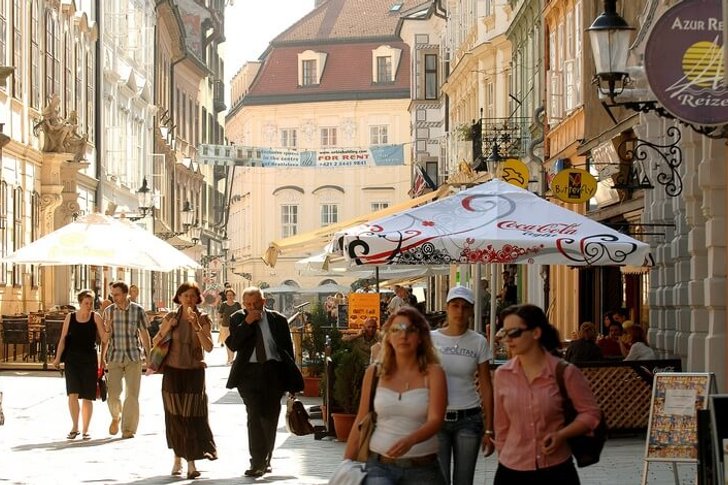
Monument plumber Chumil
The small figure of a plumber, peering curiously out of a city manhole, was created to remind people of the end of wartime, as well as to pay tribute to the honest profession of a plumber. The fact is that during the Second World War, many residents of Bratislava hid in the city sewer from the bombing, saving their lives in this way. "Chumil" in Slovak means "onlooker".

main square
The area is located in the Old City. It is a popular tourist destination surrounded by restaurants, shopping arcades selling many souvenirs, Baroque mansions and palaces. Previously, the place was called "Market Square", as city fairs were held here. In the middle is the Roland Fountain of the 16th century, which appeared on the eve of the coronation of Emperor Maximilian II.
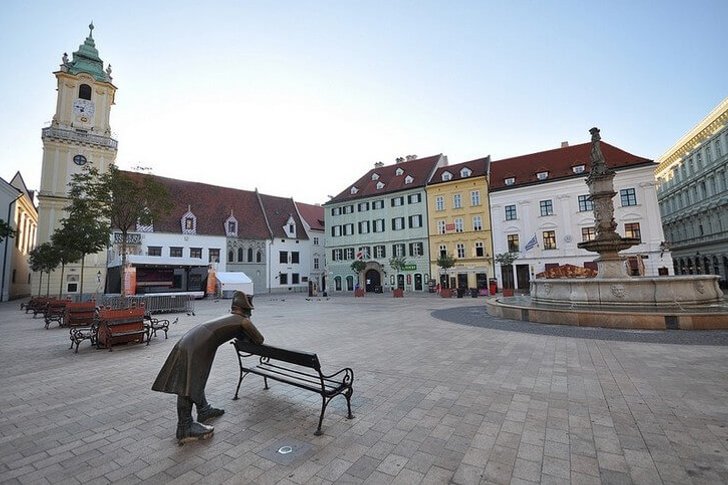
old town hall
The building of the XIII century, which began to be used as the building of the city hall in the XV century. The facades of the town hall overlook the Primacial and Main squares. The building was rebuilt and expanded several times, so several styles are mixed in the architecture from medieval Gothic to neo-Renaissance. Today, the town hall houses the City Museum, which houses an exposition dedicated to the history of Bratislava.

Bratislava castle
Bratislava Castle was built on the slopes of the Carpathians near the banks of the Danube. Historical buildings have not survived to this day, as they were destroyed in 1811 as a result of a fire. For a long time the city lay in ruins. In the middle of the 20th century, the authorities began to restore it. As a result of the work, the buildings were given the appearance that they had by the end of the 18th century. Due to the fact that the castle is located on a hill, it offers an excellent view of the Danube valley.
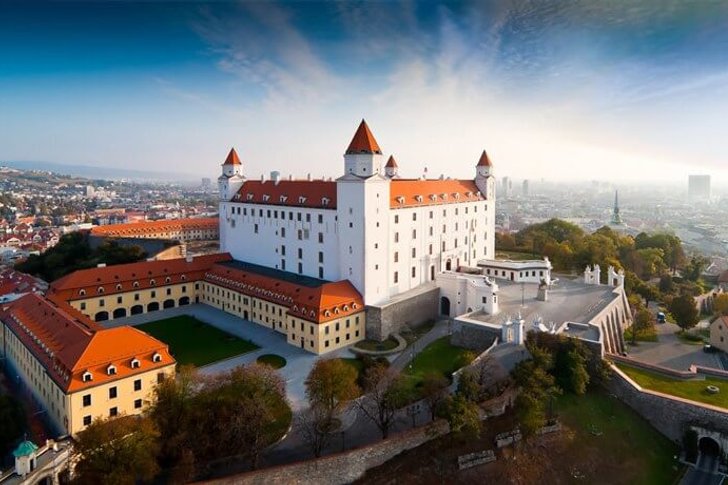
Devin Castle
Ruins of a fortress from the 9th century, located at the confluence of the Danube and Morava rivers. The castle was used for its intended purpose until the end of the 17th century. After the conquest of the territory of Slovakia by the Turks, it fell into disrepair. At the beginning of the 19th century, the soldiers of Napoleon Bonaparte blew up the building. The castle has not been restored, only in one of the halls there is a small exposition. In 1985, the remains of Devin and the surrounding land were declared a natural monument.
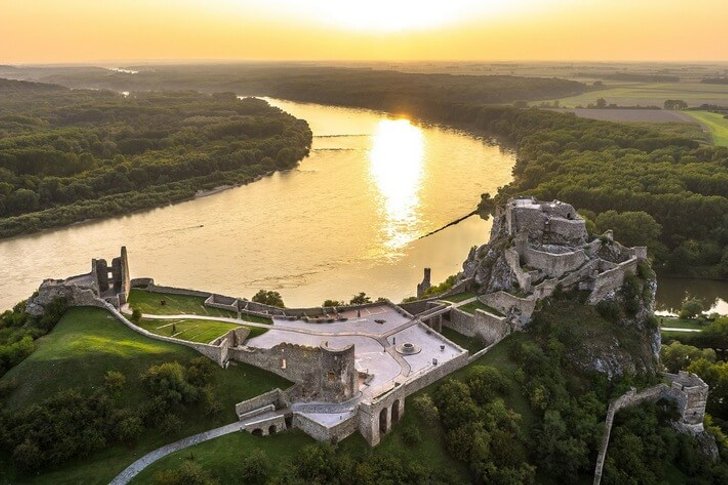
Grassalkovich Palace
The residence of the President of Slovakia, built in the middle of the XVIII century. The building was built in the Baroque style. At one time it was the most luxurious palace in Bratislava. It was built for Count A. Grassalkovich, who liked to invite famous musicians to visit him and arrange balls. The famous composer J. Haydn performed in the palace in 1772. During the communist government, the building often hosted congresses of Czechoslovak party leaders.
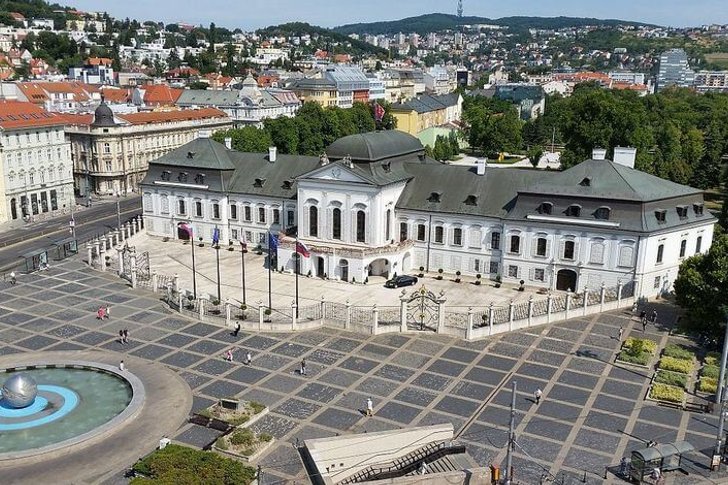
Primate's Palace
The building was erected in the 18th century in the neoclassical style. According to one version, it is believed that the building appeared in the XIV century, and in 1778 it was rebuilt and adapted to modern needs. The palace was built for the Hungarian primate - Archbishop J. Batthyani. In the 20th century, the building passed into state ownership. During the restoration, English carpets and tapestries of the 17th century were discovered, which now adorn the interior of the palace.
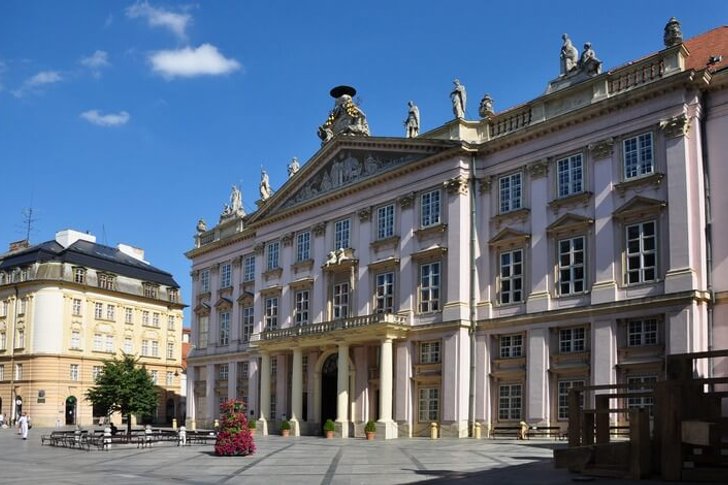
Mikhailovsky gate
Medieval gate of the 13th century (according to another version - the 14th century), the only building of its kind that has been preserved in Bratislava since those distant times. As a result of the restoration of the 18th century, the figure of St. Michael appeared on the top of the perverse tower, the whole building acquired baroque features. The structure is a tower with an observation deck 51 meters high. At the base of the structure is an archway.
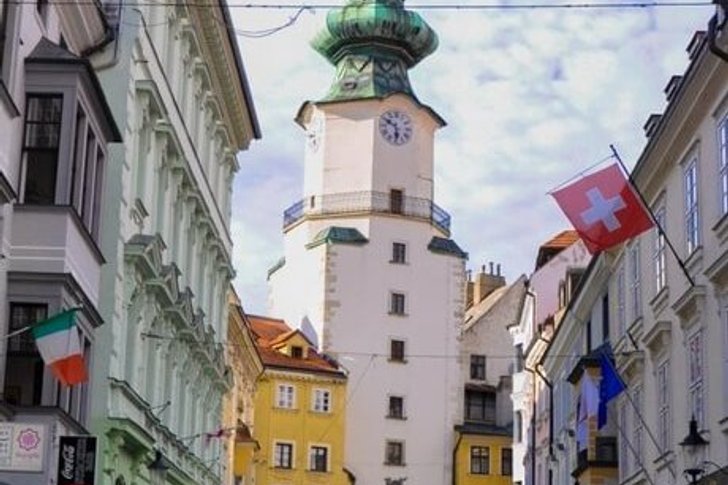
Slovak National Theater
The Slovak theater was founded at the end of the 19th century. The building was designed by the Austrian architects H. Hellner and F. Felner. The interior is decorated with frescoes by K. Spanyik, as well as paintings by L. Luttgendorf-Leinburg. At first, all productions were given in Czech, but Slovak gradually replaced it. At the main entrance there is a sculptural group of the Ganymede fountain, created by V. Tilgner.
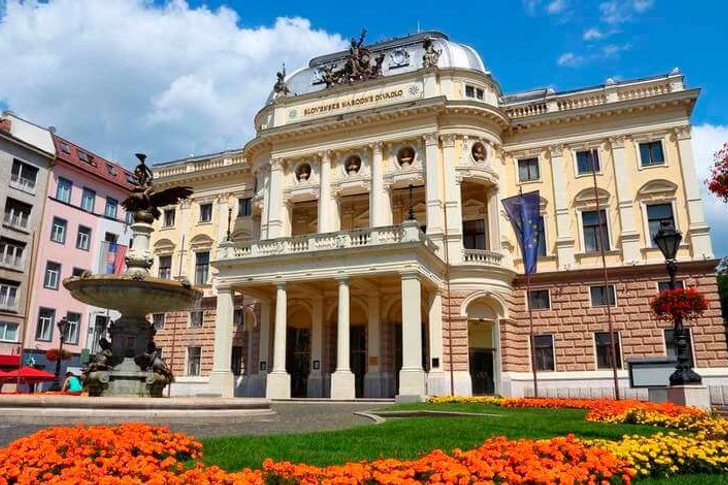
Philharmonic building
Baroque building in the historical center of Bratislava, where the local philharmonic orchestra performs. It is surrounded by promenades, restaurants and charming mansions of the surrounding neighborhoods. The building is a classic example of the architecture of the heyday of the Habsburg era, when the facades had "imperial" features, and the interiors were generously decorated with rich decor.
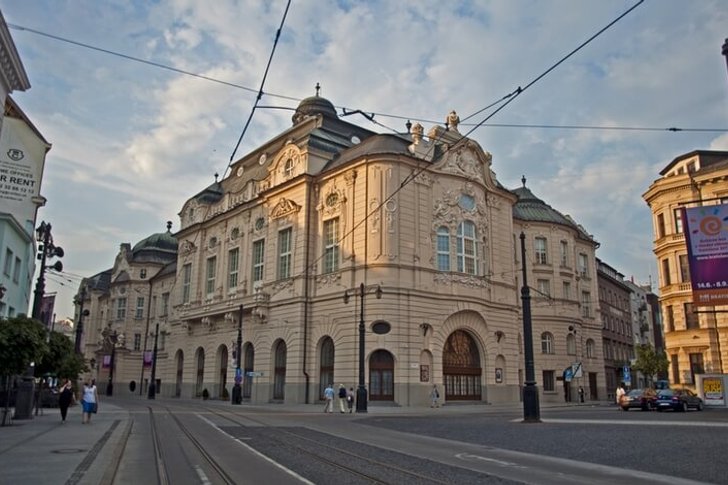
Nedbalka Gallery
City Art Gallery, which houses works of art from various eras. Unfortunately, in this museum there are no particularly outstanding works by world-famous masters, but there are quite interesting paintings by little-known artists. The gallery is better known as a unique collection of national paintings, as it exhibits an extensive collection of Slovak artists.

Cathedral of Saint Martin
The largest church in the Slovak capital and one of the oldest. The cathedral was built in the XIII century. From the 16th to the 19th centuries coronations of emperors of the Holy Roman Empire took place on its territory. This tradition originated because Bratislava in the period 1541-1684. was the capital of Hungary. The interior is in the Gothic style with some baroque features. The last reconstruction of the cathedral was carried out in the middle of the 19th century.

Capuchin Church of Saint Stephen
Temple of the 18th century, located on Zhupnaya Square. The church was built for the monks of the Capuchin order, who appeared in Bratislava in 1676, and a monastery was also built under it. The church acquired its present appearance in 1860. According to the traditions of the monastic order, the temple was built in a rather modest manner and is distinguished by its simplicity of decoration. On the square in front of the main entrance there is a column with the figure of the Virgin Mary.

Church of the Franciscans
The Catholic Church, located on the territory of the Old Town, built under the monarch Laszlo IV in the XIII century. The church was rebuilt several times, changing the features of one architectural style to another. In the 16th century, coronations of Hungarian monarchs often took place here. Initially, the building was built in the Gothic style, but the Baroque building has come down to us. Inside the church, the interior, created in the 18th century, has been preserved.
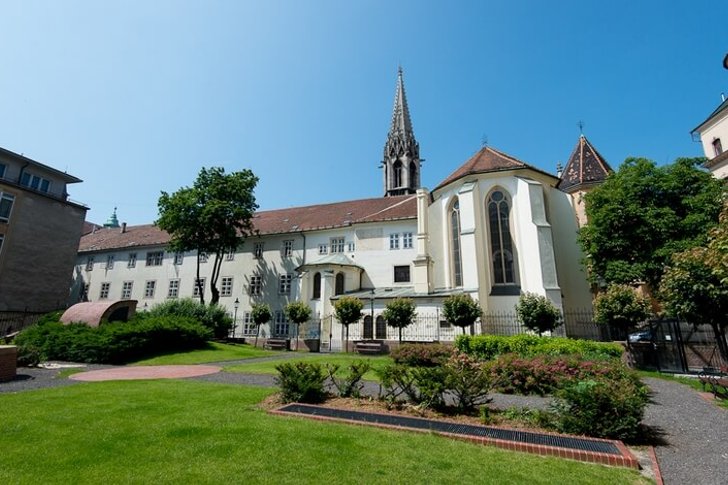
Church of Saint Elizabeth
Catholic temple of amazing beauty, located outside the historical center of the city. The church has a rather unusual appearance, original architecture and a delicate blue color of the facade. There is a legend that the church was erected at the request of Emperor Franz Joseph, who was worried about the death of his wife Elisabeth of Bavaria, but historical facts tell a different story - the temple was built at the beginning of the 20th century at the behest of Countess Sapari.
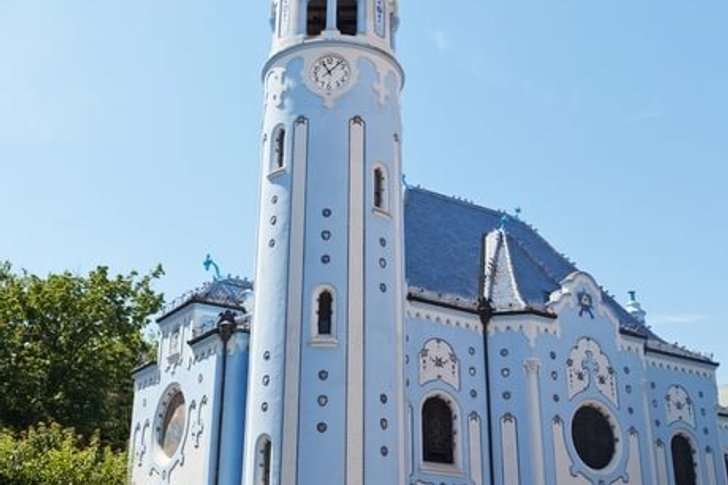
Memorial complex Slavin
The complex is dedicated to the memory of fallen soldiers during World War II. It was created in 1960 to celebrate the 15th anniversary of the liberation of Bratislava from the German occupiers. The central figure is a monument in the form of a stele 37 meters high, crowned with the figure of a warrior-liberator. The monument is located on a hill where several thousand soldiers were buried. A marble mausoleum was built over the mass grave.
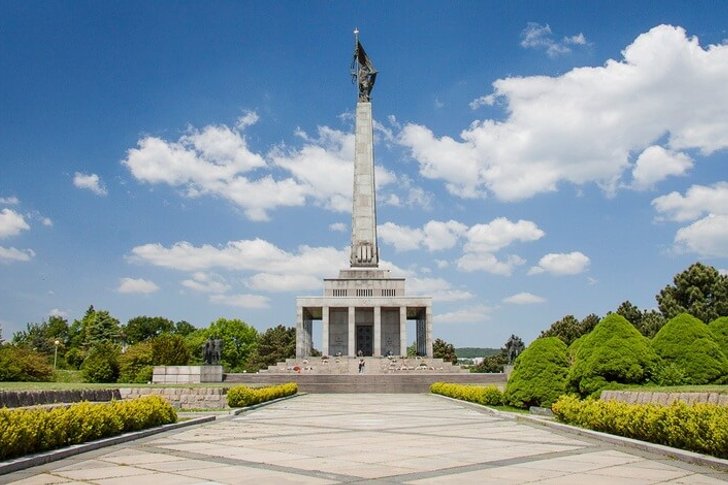
Bratislava Zoo
The zoo appeared in the 1960s. Initially, its territory was larger, but due to changes in the urban development plan, part of the land was alienated. The main purpose of the menagerie is the conservation and breeding of endangered animal species. The zoo is home to lions, lynxes, monkeys, white tigers, antelopes and panthers. There is also a children's park on the territory, where figures of prehistoric dinosaurs are installed.
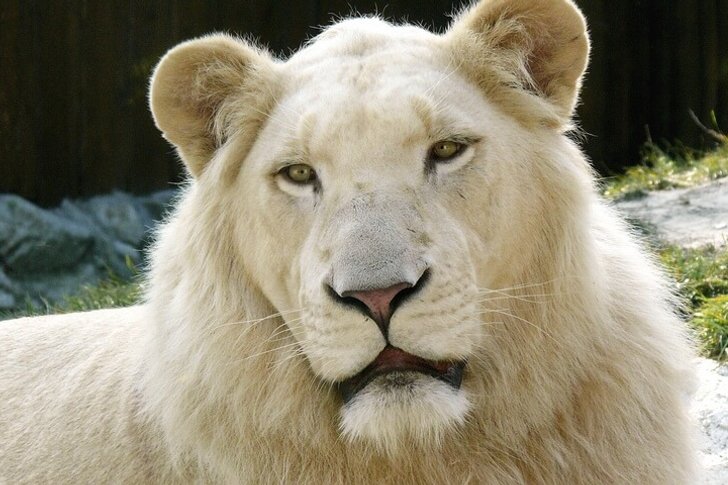
Bridge SNP
The bridge across the Danube, connecting the sleeping areas and the historical part of Bratislava, was opened in 1972. The length of the structure reaches 430.8 meters, the supports are installed only on the banks, a suspension part is laid above the water. The bridge is named after the Slovak National Uprising of 1944. At the top of the pillar there is a restaurant connected to the observation deck, which is one of the main modern attractions of Bratislava.

Apollo Bridge
The structure adorned the capital of Slovakia in the 2000s. The Apollo Bridge is 850 meters long and 32 meters wide. It especially stands out in the night panorama of Bratislava, as it is equipped with modern illumination. The need to build another bridge across the Danube arose due to the increased congestion of city highways. Engineers M. Matashtik and P. Nevechny worked on the Apollo project.
